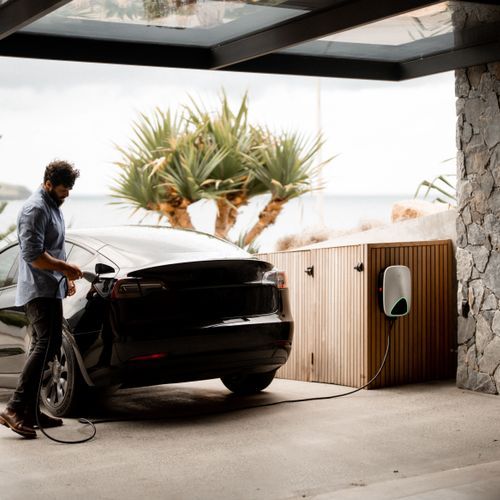Home EV Chargers
EV Charging Stations are devices that link an electric car to a power source. Essentially, an EV charging station is similar to a gas station for electric vehicles. There are three types of EV chargers: Level 1, Level 2, DC Fast charging. These charger stations are becoming more common as the world moves towards sustainable means of transportation. Get a reliable EV charging station for your electric car from trusted suppliers on ArchiPro.
What is an EV Charging Station?
Also known as an electric car charger, this system is used to provide power to electric vehicles in the same way that a gas pump is used for vehicles that run on petrol.
A cable connects the vehicle to the power source and restores the vehicle's battery. While slower than filling up with gas, it's far more environmentally friendly and most vehicles using this system have impressive mileage.
Electric vehicle chargers can be found in public locations to top up while on the road. However, home systems are increasingly popular due to their convenience and the lower cost of power on private property.
Uses of Electric Car Charging Stations
The primary purpose of any EV station is to transfer power to vehicles. However, there are subtle differences in the way systems work, making each type suitable for different applications.
Home EV Charging Station
A home EV charging station uses a home's power to fill up the battery. It is designed for personal use and is typically attached to a wall. Home electric vehicle chargers may provide power more slowly than commercial models.
Smart EV Chargers
Smart EV chargers can be installed in residential properties or public areas. These "communicate" with the car to find out how much power it requires and balance the flow of power with the capabilities of the grid.
These can be used to avoid going over predetermined energy tariffs and to provide power more efficiently where it's needed.
Commercial EV Charging
Commercial models are often freestanding and are located by the side of the road or in car parks. Motorists can pay to plug their vehicles into these systems to provide power on the road. They're often found at service stations for this reason.
Types of Electric Vehicle Charging Station
Level 1 EV Chargers
Level 1 units are often supplied with the vehicle and are often preferred for home use. They provide a low level of power and can operate from a 120v, 20 amp wall socket — this makes them desirable in countries like the U.S., where this is the standard power provided by wall sockets.
This is less of a concern in countries like New Zealand and the U.K. that use 230V, but the lower power draw is still considered beneficial for home use.
Level 2 EV Chargers
Level 2 units require up to 240V with 40 amps of resistance, meaning that they can be used with standard home power sockets in New Zealand and other countries with higher home voltage. These models provide far more power and the car to fill up much faster, making them desirable for commercial use and for homeowners who need quick access to power.
DC Fast Charger
This is a super-fast electric vehicle charging station that is usually used for commercial EV charging. These allow cars to be fully powered up in 60-90 minutes and are often found at motorway service stations. The high power draw means that they're rarely seen in residential properties, although adaptations can be made to permit this.
EV Charging Station Styles
The way a station is installed depends on its location. For example, home users will typically connect the car to a wall socket, especially if it's a lower-power level 1 model. Commercial installations are usually freestanding for easier access from the roadside, although freestanding models can also be installed in homes.
EV Wall Charger
Some models can connect directly to a wall socket, meaning that the apparatus is mostly just a cable. However, many systems can be installed onto a wall separately from sockets — this means that they don't take up socket space that could be used for other applications. It also allows the unit to be positioned outside a house, which is advantageous for many drivers as it allows better accessibility.
Freestanding Electric Vehicle Charging Station
Freestanding models can be placed anywhere as long as there's electricity. This can improve accessibility, especially for larger residential parking areas or if a homeowner has multiple electric vehicles. In addition, they are compatible with other car parking solutions.
These models are also commonly used in commercial applications, as it allows the car to pull up next to the power source without needing to park near a wall.
EV Charger Installation & Operation
Installation is usually handled by professionals. This is especially true for higher-power models where special modifications need to be made for the increased power draw.
Once installation is complete, the operation is relatively straightforward — a cable is connected to the car and can be left plugged in for as long as necessary. Some smart models come with a phone app that can be used to monitor the power.
What's the Best Electric Car Charger?
The best choice depends on the needs of the user. For commercial buyers such as apartment managers, higher power units can make a property more attractive to prospective tenants. For many private users, lower-power systems are more efficient and reduce the need for special installation.




